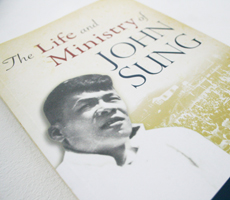A novel contribution to research on the life and work of John Sung (1901-1944) has been made in the form of a new biography of the 20th century revivalist exploring contextual and historical factors that shaped his life and legacy.
The Life and Ministry of John Sung (Armour Publishing) is the first properly researched work on the Chinese revivalist since a groundbreaking biography written over half a century ago.
Dr. Lim Ka-Tong, a pastor, wrote the 352-page biography to help readers understand Sung’s effectiveness as an evangelist and his influence in the life and vibrancy of Chinese Christianity.
The book shows how Sung was providentially nurtured, used and protected from spiritual and physical harm throughout his entire life.
His pastor father’s preaching ability and commitment to prayer – and the answers to prayer - impacted Sung. He received his calling in life when he secretly vowed to become a preacher if God would heal his sick brother.
During his student days in America, he fell into emptiness and suffered a nervous breakdown after embracing modernist ideas about religion. Then he attended a revival meeting out of curiosity. The devotion and spirituality of the speaker, a teenage evangelist, moved him.
After further struggle, he made a prayer of confession and asked God to deliver him from his torments. His faith was restored.
However, the principal of the seminary where he studied misinterpreted his newfound zeal for God. And he was sent to a psychiatric institution for treatment. During his 193-day stay, he read the entire Bible 40 times. There, he received special revelation to understand his mission ahead.
On his return to China, Sung found himself speaking at Bethel Tabernacle. This was just two weeks before the consecration of the Bethel Worldwide Evangelistic Band, which he later joined. It was the Band which launched him into nationwide prominence.
While in Nanchang for ministry, he learned the secret of revival through the passionate prayers of a missionary. Having been personally revived, he went on tour with the Bethel Band.
When the Band made its first visit, to Qingdao, it was during the initial phase of the Shandong Revival.
The Band visited Mukden (now Shenyang) and left on the last train on September 18, 1931. That same evening, a section of the railway track outside Shenyang was blown up by explosives from the Imperial Japanese Army.
Sung was in Shanghai before and during the Japanese attacks in 1932. Again he was kept safe.
Then the revivalist parted ways with the Bethel Mission. By this time, he had gone from being a young countryside preacher to a countrywide evangelist.
Sung was used by God to bring revival to China and Southeast Asia in the 1930s. This served to prepare people for great trials and hardships during the imminent Japanese colonisation of the regions.
In the book, Dr. Lim argues that Sung and other independent Chinese preachers were the main contributing factors to the resurgence in the Christian faith during the early half of the 20th century in China.
Vibrant seeds of renewal were planted in the Chinese Church. This enabled the Church not only to withstand the trial of fire after the Communist takeover of China in 1949. Indeed, the Church grew from less than one million in 1949 to over 35 million, if not 50 million in 1982, according to an estimate.
Sung’s key contribution toward the Chinese Church was his training and setting up of preaching bands at his revival meetings. These were teams comprising two to five Christians that would engage in personal evangelism in towns and villages. The revivalist encouraged these lay Christians to see themselves as pillars of the church.
When the Chinese churches were forced to close, many pastors and church leaders were sent for re-education. Members of the preaching bands were sufficiently equipped to step forward to provide pastoral care and witness to their non-Christian friends wherever possible.
Many churches were without pastors and elders for many years. After their release years later, the leaders were in for a surprise. They found that their churches had grown many times larger than before.
The book was released in commemoration of the 110th anniversary of Sung’s birth.

















